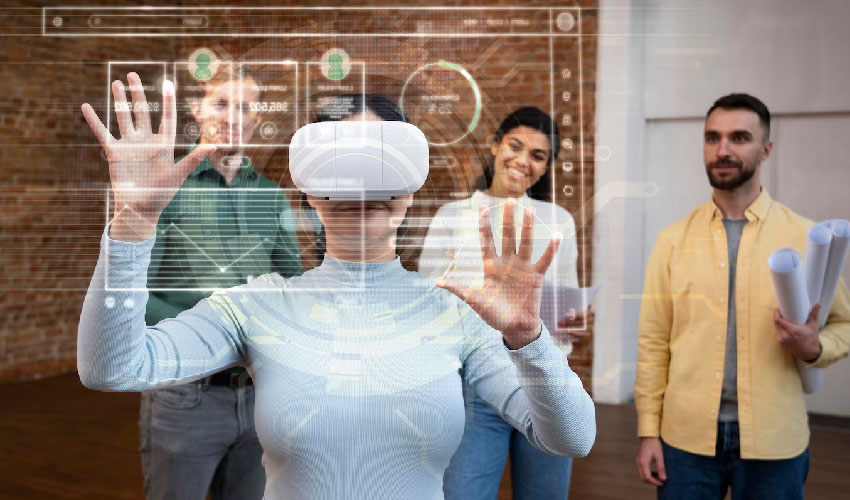Table of Contents
I. Introduction
A. Definition of Augmented Reality (AR)
Augmented Reality refers to the integration of digital information, such as images or 3D models, into the user’s real-world environment. Unlike Virtual Reality (VR), which immerses users in a completely virtual experience, AR enhances the real world by overlaying digital elements onto it.
B. Brief history of AR in mobile app development
The journey of AR in mobile app development dates back to the early 2000s, but it gained significant traction with the advent of smartphones. Technological advancements and the evolution of mobile devices have paved the way for the seamless integration of AR into various applications.
II. Evolution of Mobile App Development
A. Traditional app development
Traditionally, mobile apps were confined to two-dimensional screens, limiting user interactions to touch and swipe. The emergence of AR has revolutionized this landscape by introducing three-dimensional, interactive elements.
B. Emergence of AR in the industry
The rise of AR in mobile app development can be attributed to its ability to provide users with a more immersive and engaging experience. Developers are now leveraging AR to create applications that blur the lines between the physical and digital worlds.
C. Impact on user experience
AR has redefined user experience by enabling real-world interactions within the app environment. Users can now engage with digital content in their physical surroundings, creating a dynamic and captivating experience.
III. Key Features of Augmented Reality in Apps
A. Real-world interaction
One of the defining features of AR is its capability to interact with the user’s immediate environment. This opens up new possibilities for gaming, education, and practical applications like interior design and navigation.
B. Enhanced user engagement
AR enhances user engagement by providing a more immersive and interactive experience. Apps that incorporate AR features are more likely to capture and retain the user’s attention.
C. Integration of virtual elements
Developers can seamlessly integrate virtual elements into the real world through AR. This could range from placing virtual furniture in a room using an interior design app to overlaying information on historical landmarks through a travel guide application.
D. Examples of successful AR apps
Several AR apps have gained widespread popularity, showcasing the diverse applications of this technology. Pokémon GO, Snapchat filters, and IKEA Place are prime examples of successful AR implementations.
IV. Benefits for Developers
A. Increased user retention
AR adds a layer of novelty to mobile apps, increasing user retention rates. Users are more likely to revisit an app that offers a unique and engaging AR experience.
B. Competitive edge
As AR becomes more prevalent, developers who embrace this technology gain a competitive edge. Users are increasingly seeking apps that go beyond the conventional, and AR provides a means to stand out in a crowded market.
C. Monetization opportunities
AR opens up new monetization avenues for developers. From in-app purchases related to AR features to partnerships with brands for sponsored AR content, developers can explore diverse revenue streams.
V. Challenges in Implementing AR
A. Technical complexities
Despite its potential, AR implementation comes with technical challenges. Developers must overcome issues related to hardware compatibility, real-time tracking, and the seamless integration of virtual elements.
B. User acceptance
While AR has gained popularity, some users may still be hesitant to fully embrace this technology. Overcoming skepticism and ensuring widespread user acceptance are ongoing challenges for developers.
C. Development costs
The integration of AR features may incur additional development costs. Balancing the benefits against the investment is a crucial consideration for developers, particularly those with budget constraints.
VI. AR Platforms and Tools
A. Overview of popular AR development platforms
Various platforms, such as ARKit (iOS) and ARCore (Android), provide developers with tools to integrate AR into their apps. Understanding the strengths and limitations of these platforms is essential for effective development.
B. Comparison of tools available for developers
Developers can choose from a range of AR development tools, each offering unique features. Analyzing and comparing these tools ensures that developers make informed decisions based on the specific requirements of their projects.
VII. Case Studies
A. Successful AR app stories
Examining successful AR app stories provides valuable insights into effective implementation strategies. Apps like Snapchat and Pokémon GO have not only captured user interest but also set benchmarks for AR success.
B. Lessons learned from failures
Understanding failures is equally important. Analyzing apps that struggled to gain traction helps developers avoid common pitfalls and refine their AR development strategies.
VIII. Future Trends in AR Development
A. Advancements in AR technology
The future of AR development holds exciting possibilities, with ongoing advancements in technology. From improved hardware capabilities to more sophisticated AR algorithms, the landscape is set to evolve rapidly.
B. Potential industries impacted by AR
AR is not limited to entertainment; it has the potential to revolutionize various industries. Healthcare, education, and retail are among the sectors that stand to benefit significantly from AR integration.
C. Predictions for the future of AR in mobile apps
Experts predict a continued rise in the adoption of AR in mobile app development. As technology advances and user acceptance grows, AR is likely to become a standard feature in a wide range of applications.
IX. Tips for Effective AR Integration
A. User-centered design
Prioritize user experience in AR development. Designing with the end user in mind ensures that AR features enhance, rather than detract from, the overall app experience.
B. Testing and optimization
Thorough testing is crucial for successful AR integration. Developers should conduct extensive testing to identify and address any issues related to performance, compatibility, and user interface.
C. Continuous improvement
AR development is an iterative process. Developers should actively seek user feedback, analyze app performance, and implement updates to ensure continuous improvement and user satisfaction.
X. Conclusion
A. Recap of the impact of AR on mobile app development
In conclusion, the rise of Augmented Reality has profoundly impacted mobile app development. From transforming user experiences to providing developers with new opportunities, AR is a force to be reckoned with in the ever-evolving world of technology.
B. Looking ahead to the future possibilities
As we look ahead, the future of AR in mobile apps appears promising. With ongoing advancements and increasing acceptance, developers have a vast canvas to explore, creating innovative and captivating experiences for users.
Thanks for reading our post “The Rise of Augmented Reality (AR) in Mobile App Development”. Please connect with us to know more about The Rise of Augmented Reality.














